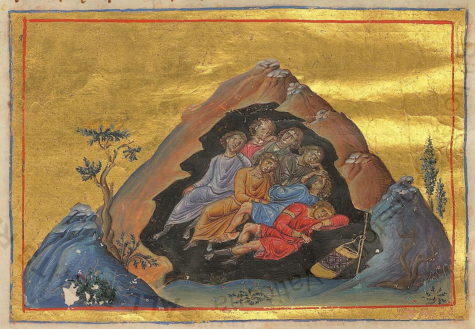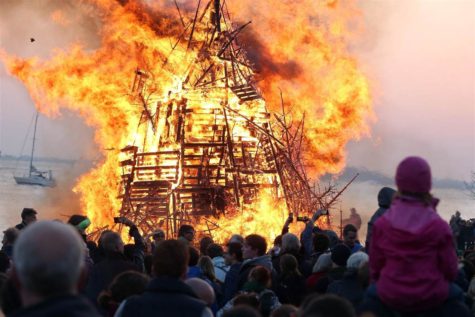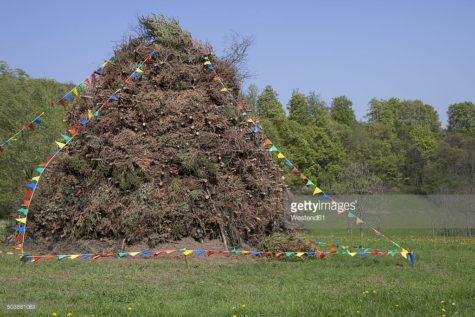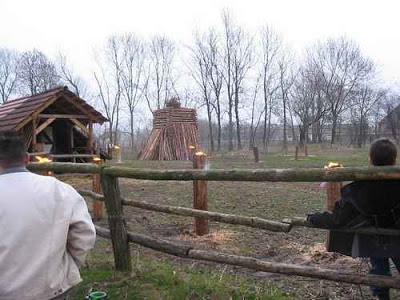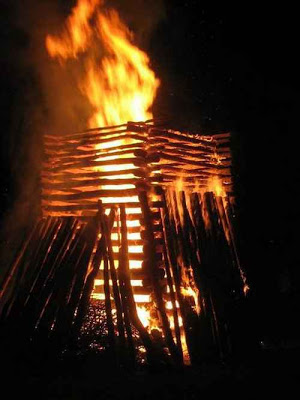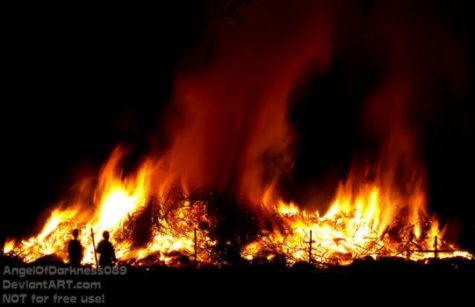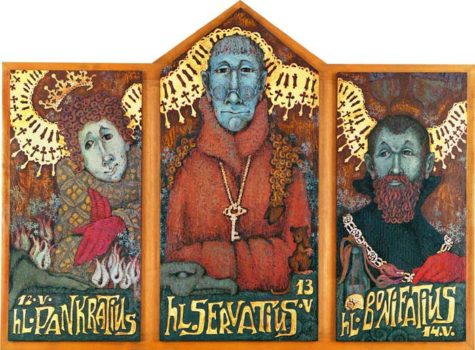Germany
Seven Sleepers’ Day (Siebenschläfertag) on June 27 is a feast day commemorating the legend of the Seven Sleepers as well as one of the best-known bits of traditional weather lore (expressed as a proverb) remaining in German-speaking Europe.
The atmospheric conditions on that day are supposed to determine or predict the average summer weather of the next seven weeks. and it is believed that whatever the weather is on this day, it will remain so for seven weeks.
Apparently this forecast is about as accurate as Groundhog Day forecasts in the U.S. The story of the Seven Sleepers has many versions and is widespread throughout the Christian and Muslim worlds. It has been told and retold repeatedly from ancient times to the present day.
The Story of the Seven Sleepers
The earliest Syriac version of the tale states that during the persecutions of the Roman emperor Decius, around 250, seven young men were accused of being Christians. They were given some time to recant their faith, but chose instead to give their worldly goods to the poor and retire to a mountain cave to pray, where they fell asleep.
The emperor, seeing that their attitude towards their faith had not changed, ordered the mouth of the cave to be sealed. Decius died in 251, and many years passed during which Christianity went from being persecuted to being the state religion of the Roman Empire. At some later time—usually given as during the reign of Theodosius II (408–450)—the landowner decided to open up the sealed mouth of the cave, thinking to use it as a cattle pen. He opened it and found the sleepers inside.
They awoke, imagining that they had slept for a single day, and sent one of their number to Ephesus to buy food, with instructions to be careful in case the Romans were to recognize him and seize him. Upon arriving in the city, this youth was astounded to find buildings with crosses attached. The townspeople for their part were amazed to find a man trying to spend old coins from the reign of Decius. The bishop was summoned to interview the sleepers; they told him their miracle story, and died praising God.
As the earliest versions of the legend spread from Ephesus, an early Christian catacomb came to be associated with it, attracting scores of pilgrims. On the slopes of Mount Pion near Ephesus, the cave of the Seven Sleepers with ruins of the church built over it was excavated in 1927–28. The excavation brought to light several hundred graves which were dated to the 5th and 6th centuries. Inscriptions dedicated to the Seven Sleepers were found on the walls of the church and in the graves. This cave is now a local tourist attraction.
The story of the Seven Sleepers is probably best known in the Muslim world. It is told in the Qur’an (Surah 18, verse 9-26). The Qur’anic rendering of this story doesn’t state exactly the number of sleepers; the exact number is believed to be known to God alone. It also gives the number of years that they slept as 300 solar years (equivalent to 309 lunar years).
Unlike the Christian story, the Islamic version includes mention of a dog who accompanied the youths into the cave, and was also asleep. But when people passed by the cave it looked as if the dog was just keeping watch at the entrance, making them afraid of seeing what is in the cave once they saw the dog. In Islam, these youths are referred to as “The People of the Cave.”
There are numerous retellings of the tale in early modern and modern literature. John Donne’s (1572-1631) poem “The good-morrow” contains the lines:
were we not wean’d till then?
But suck’d on country pleasures, childishly?
Or snorted we in the Seven Sleepers’ den?”
A Recipe For Today
Given that the sleepers were hungry when they awoke and sent one of their number to buy food, I thought a local Turkish recipe found at roadside food stalls would be suitable for the day. Gözleme are flaky pastry packets stuffed with a mix of feta cheese and spinach plus herbs and spices. Variants can be found throughout Turkey and Greece. They can also be stuffed with ground lamb flavored with garlic, paprika, and cumin. Once in a while you will come across them with both fillings in one.
Ingredients:
Dough
- 2 cups (250 g) plain flour, unbleached
- 2 cups (250 g) wholemeal flour
- pinch of salt
- vegetable oil
Filling
- 2 cups (450 g) grated feta cheese or
- 2 cups (200 g) finely chopped spinach leaves
- ½ cup (50 g) chopped fresh mint leaves
- ½ cup (50 g)chopped flat leaf parsley
- ½ cup (80 g) chopped green onion
- ½ cup (80 g) diced white onion
- 1 tsp (5 g) white pepper
- 1 tsp (5 g) allspice
- 1 tsp (5 g) dried oregano
- 1 tsp (5 g) dried sage
Instructions:
Sift the flours and salt and mix with 1 ½ cups (210 ml) of water in an electric mixer with a dough hook or knead by hand for at least ten minutes.
Keep adding more water a little at a time until you get a very pliable, elastic dough that is easy to knead, but not so watery that it is too sticky to handle. Dust frequently with the extra flour.
Allow the dough to stand, covered, overnight (at least 10 hours). When ready to cook, divide the dough into six round portions. Dust with flour. Roll one of the rounds flat with a rolling pin on a flour-dusted surface, into a rectangle shape, as thinly as possible.
Brush on a little oil, then fold over into a square. Fold over twice more into a square. Repeat the dusting, rolling out to a large rectangle, folding, oiling, dusting process three more times. Repeat the entire process for each of the six rounds
Take one of the folded dough squares and roll it out very thinly for the final time, into a large square. Sprinkle on the filling sparingly – – as you would for a pizza topping but on half of the square only.
Start with a layer of cheese. Mix the spinach, mint, green onion and parsley together in a bowl, and add some of this as the next layer. Mix together the white onion, spices, and dried herbs, and add some as a final topping.
Fold over the uncovered half of the square to cover the filling. Press down lightly all over.
Cook on a pre-heated oiled heavy skillet (cast iron if possible). Make sure the skillet is not too hot. It takes about 10 minutes to cook everything through. Turn them often until the outside is golden and crisp. Cut into smaller squares and serve with lemon wedges. Yield 6.
Some Weather Science
The Seven Sleepers singularity is contested as quite inaccurate in practice. Objections have been raised that the weather lore associated with the day might have arisen before the 1582 Gregorian calendar reform, and as at this time the difference to the Julian calendar amounted to ten days, July 7 would be the actual Seven Sleepers Day. Based on this date the prediction has a slightly increased probability of about 55–70%, if confined to the southern parts of Germany, where the rule seems to have originated. In contrast, the weather lore is not applicable to Northern Germany and its rather oceanic climate.
Depending on the meandering flow of the polar jet stream in the Northern Hemisphere (Rossby waves) and the emergence of veering low-pressure and high-pressure (anticyclone) systems, the atmospheric conditions tend to stabilize in early July: either a high-pressure ridge takes hold over Scandinavia, which may coalesce with the subtropical Azores High to form a stable and warm macro weather situation; or a high North Atlantic oscillation between the Icelandic Low and the Azores High implies a long-standing influx of wet air masses into Central Europe.
Sources:
The Easter Fire is a custom of pagan origin spread all over Europe. It is a symbol of victory, the victory of beautiful and sunny spring over the cold days of winter.
On Holy Saturday or Easter Sunday, in rare occasions also on Easter Monday, large fires are lit at dusk in numerous sections of Northwestern Europe. These regions include Denmark, parts of Sweden as well as in Finland, Northern Germany, Switzerland, and Austria.
The fire is lit usually on the top of the mountains – Easter mountain, Osterberg – and it is obtained from wood by friction. In Germany, the Easter fire is created by gathering all the Christmas trees and burning them into a huge fire, a sign for everyone to leave behind winter and prepare for spring.
Though not documented before the 16th century, the custom presumably is based on Saxon, pre-Christian traditions, that are still performed each year. There are several explanations of the meaning of these fires. The Saxons believed that around the time of Easter, Spring becomes victorious over Winter. The fires were to help chase the darkness and winter away. It was also a symbol of fertility, which works in a literal sense in that the ashes were scattered over the meadows and thereby fertilized the soil.
The pre-Christian meaning of Easter fires is hardly experienced anymore. Nowadays they are meant to bring the community together, which guarantees a pleasant night combined with the consumption of beer, mulled wine or liquor, and snacks.
Source: Wikipedia
May 11, 12, and 13 are the feast days of Saints Mamertus, Pancras, and Gervais. These three are known as the Three Chilly Saints not because they were cold during their lifetimes, but because these days bring a brief spell of colder weather in many years, including the last nightly frosts of the spring, and are traditionally the coldest of the month.
English and French folklore (and later American) held that these days would bring a late frost. In Germany, they were called the Icemanner, or Icemen Days, and people believed it was never safe to plant until the Icemen were gone. Another bit of folklore claimed:
“Who shears his sheep before St. Gervatius’s Day loves more his wool than his sheep.”
In Sweden, the German legend of the ice saints has resulted in the belief that there are special “iron nights,” especially in the middle of June, which are susceptible to frost. The term “iron nights” (järnnätter) has probably arisen through a mistranslated German source, where the term “Eismänner” (ice men) was read as “Eisenmänner” (iron men) and their nights then termed “iron nights,” which then became shifted from May to June.
To the Poles, the trio are known collectively as zimni ogrodnicy (cold gardeners), and are followed by zimna Zośka (cold Sophias) on the feast day of St. Sophia which falls on May 15. In Czech, the three saints are collectively referred to as “ledoví muži” (ice-men or icy men), and Sophia is known as “Žofie, ledová žena” (Sophia, the ice-woman).
Alternative Saints:
St. Mamertus is not counted among the Ice Saints in certain countries (Southern Germany, Austria, Northern Italy, Czech Republic, etc.), whereas St. Boniface of Tarsus belongs to them in other countries (Flanders, Liguria, Czech Republic etc.) as well; St. Boniface’s feast day falling on May 14. St. Sophia, nicknamed Cold Sophia (German kalte Sophie) on May 15 can be added in Germany, Alsace (France). In Poland and the Czech Republic, the Ice Saints are St. Pancras, Saint Servatus and St. Boniface of Tarsus.
Related Content:
- A nice little spell, Ice Saint Toxic People Banishing Spell, can be found at The Book of Shadows
Note:
The introduction of the Gregorian Calendar in 1582 involved skipping 10 days in the calendar, so that the equivalent days from the climatic point of view became May 22–25.
Found at: Almanac.com and wikipedia
